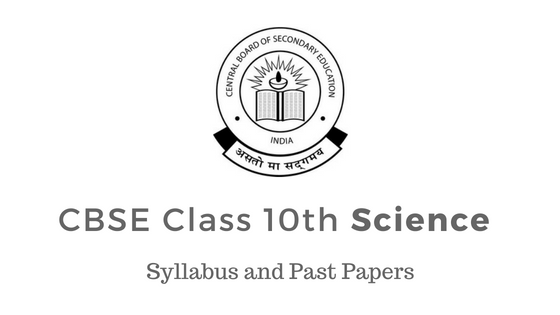Class X Science Syllabus 2024-25. Check out CBSE Class 10th Science Syllabus, CBSE Class 10th Science Previous year question papers, CBSE Class 10th Science Sample Papers. Check out CBSE Class 10th Syllabus and Past Papers of other CBSE Class 10th Course CBSE Class 10th Science Syllabus 2024-25 and Past Papers, CBSE Class 10th Mathematics Syllabus 2024-25 and Past Papers, CBSE Class 10th English Language And Literature Syllabus 2024-25 and Past Papers, CBSE Class 10th English Communicative Syllabus 2024-25 and Past Papers, CBSE Class 10th Social Science Syllabus 2024-25 and Past Papers or check out CBSE Class 10th Previous Year Question Papers and Sample Papers Solved. Continue to read for CBSE Class 10th Syllabus Science.
SECTION – WISE WEIGHTAGE : CBSE Class 10th SCIENCE 2024-25
The board examination will be of 80 Marks.
| Unit No. | Unit | Marks |
| I | Chemical Substances – Nature and Behaviour | 25 |
| II | World of Living | 25 |
| III | Natural Phenomena | 12 |
| IV | Effects of Current | 13 |
| V | Natural Resources | 05 |
| Total | 80 | |
| Internal assessment | 20 | |
| Grand Total | 100 |
Note : Above weightage includes the weightage of questions based on practical skills.
Internal Assessment (20 Marks)
- Periodic Assessment – 05 marks + 05 marks
- Subject Enrichment (Practical Work) – 05 marks
- Portfolio – 05 marks
Science Exam Paper Format and Syllabus 2024-25
Unit I : Chemical Substances – Nature and Behaviour
(Suggested number of Periods : 55 Periods)
Chemical reactions : Chemical equation, Balanced chemical equation, implications of a balanced chemical equation, types of chemical reactions: combination, decomposition, displacement, double displacement, precipitation, endothermic exothermic reactions, oxidation and reduction.
Acids, bases and salts: Their definitions in terms of furnishing of H+ and OH– ions, General properties, examples and uses, neutralization, concept of pH scale (Definition relating to logarithm not required), importance of pH in everyday life; preparation and uses of Sodium Hydroxide, Bleachingpowder, Baking soda, Washing soda and Plaster of Paris.
Metals and nonmetals: Properties of metals and non-metals; Reactivity series; Formation and properties of ionic compounds; Basic metallurgical processes; Corrosion and its prevention.
Carbon compounds: Covalent bonding in carbon compounds. Versatile nature of carbon. Homologous series. Nomenclature of carbon compounds containing functional groups (halogens, alcohol, ketones, aldehydes, alkanes and alkynes), difference between saturated hydro carbons and unsaturated hydrocarbons. Chemical properties of carbon compounds (combustion, oxidation, addition and substitution reaction). Ethanol and Ethanoic acid (only properties and uses), soaps and detergents.
Periodic classification of elements : Need for classification, Early attempts at classification of elements (Dobereiner’s Triads, Newland’s Law of Octaves, Mendeleev’s Periodic Table), Modern periodic table, gradation in properties, valency, atomic number, metallic and non-metallic properties.
Unit II : World of Living
( Suggested number of Periods: 50 Periods)
Life processes : ‘Living Being’. Basic concept of nutrition, respiration, transport and excretion in plants and animals.
Control and co-ordination in animals and plants : Topic movements in plants; Introduction of plant hormones; Control and co-ordination in animals; Nervous system; Voluntary, involuntary and reflex action; Chemical co-ordination: animal hormones.
Reproduction : Reproduction in animals and plants (asexual and sexual) reproductive health-need and methods of family planning. Safe sex vs HIV / AIDS. Child bearing and women’s health.
Heredity and Evolution : Heredity; Mendel’s contribution- Laws for inheritance of traits: Sex determination: brief introduction: (topics excluded – evolution; evolution and classification and evolution should not be equated with progress).
Unit III : Natural Phenomena
(Suggested number of Periods: 23 Periods)
Reflection of light by curved surfaces; Images formed by spherical mirrors, centre of curvature, principal axis, principal focus, focal length, mirror formula (Derivation not required),magnification.
Refraction; Laws of refraction, refractive index. Refraction of light by spherical lens; Image formed by spherical lenses; Lens formula (Derivation not required); Magnification. Power of a lens.
Functioning of a lens in human eye, defects of vision and their corrections, applications of spherical mirrors and lenses.
Refraction of light through a prism, dispersion of light, scattering of light, applications in daily life. (excluding colour of the sun at sunrise and sunset).
Unit IV : Effects of Current
(suggested number of periods: 32 Periods)
Electric current, potential difference and electric current. Ohm’s law; Resistance, resistivity, Factors on which the resistane of a conductor depends. Series combination of resistors, parallel combination of resistors and its applications in daily life. Heating effect of electric current and its applications in daily life. Electric power, Interrelation between P, V, I and R.
Magnetic effects of current : Magnetic field, field lines, field due to a current carrying conductor, field due to current carrying coil or solenoid; Force on current carrying conductor, Fleming’s Left Hand Rule, Direct Current. Alternating current : frequency of AC. Advantage of AC over DC. Domestic electric circuits.
Unit V : Natural Resources
(Suggested Number of Periods: 20 Periods)
Our environment: Eco-system, Environmental problems, Ozone depletion, waste production and their solutions. Biodegradable and non-biodegradable substances.
CBSE Class 10th Science Practicals 2024-25
Practicals should be conducted alongside the concepts taught in theory classes.
List of Experiments
- Finding the pH of the following samples by using pH paper / universal indicator:
Studying the properties of acids and bases (HCl & NaOH) by their reaction with:
- Litmus solution (Blue/Red)
- Zinc metal
- Solid sodium carbonate
- Performing and observing the following reactions and classifying them into :
- Observing the action of Zn, Fe, Cu and Al metals on the following salt solutions:
- Studying the dependence of potential difference (V) across a resistor on the current (I) passing through it and determine its resistance. Also plotting a graph between V and I.
- Determination of the equivalent resistance of two resistors when connected in series and parallel.
- Preparing a temporary mount of a leaf peel to show stomata.
- Experimentally show that carbon dioxide is given out during respiration.
- Study of the following properties of acetic acid (ethanoic acid) :
- Study of the comparative cleaning capacity of a sample of soap in soft and hard water.
- Determination of the focal length of :
- Tracing the path of a ray of light passing through a rectangular glass slab for different angles of incidence. Measure the angle of incidence, angle of refraction, angle of emergence and interpret the result.
- Studying (a) binary fission in Amoeba, and (b) budding in yeast with the help of prepared slides.
- Tracing the path of the rays of light through a glass prism.
- Identification of the different parts of an embryo of a dicot seed (Pea, gram or red kidney bean).
CBSE Class 10 Science Chapter-Wise Marks Distribution
| Chapter Name | Total Marks |
| 1. Chemical Reactions and Equations | 6 |
| 2. Acids, Bases and Salts | 3 |
| 3. Metals and Non-metals | 10 |
| 4. Carbon and its Compounds | 6 |
| 5. Life Processes | 9 |
| 6. Control and Coordination | 6 |
| 7. How do Organisms Reproduce? | 3 |
| 8. Heredity | 7 |
| 9. Light – Reflection and Refraction | 10 |
| 10. The Human Eye and the Colourful World | 2 |
| 11. Electricity | 7 |
| 12. Magnetic Effects of Electric Current | 6 |
| 13. Our Environment | 5 |
| Total | 80 |
CBSE Class X Science Prescribed Books
- Science – Textbook for class IX – NCERT Publication
- Science – Textbook for class X – NCERT Publication
- Assessment of Practical Skills in Science – Class IX – CBSE Publication
- Assessment of Practical Skills in Science – Class X – CBSE Publication
- Laboratory Manual – Science – Class IX, NCERT Publication
- Laboratory Manual – Science – Class X, NCERT Publication
- Exemplar Problems – Class IX – NCERT Publication
- Exemplar Problems Class X – NCERT Publication
CBSE Class 10th Science Question Paper Format And Design
The CBSE Class 10 Science Question Paper 2024 will be divided into 5 sections:
- Section A: Objective Type Questions (20 marks)
- Section B: Short Answer Type Questions – I (12 marks)
- Section C: Short Answer Type Questions – II (21 marks)
- Section D: Long Answer Type Questions (15 marks)
- Section C: Case Study Based Questions (12 marks)
Detailed structure of the CBSE Class 10 Science Question Paper:
| Section | Number of Questions | Marks per Question | Weightage (in Marks) |
| Section A: MCQs | 20 | 1 | 20 |
| Section B: Short Anwer Type Questions-I | 6 | 2 | 12 |
| Section C: Short Anwer Type Questions-II | 7 | 3 | 21 |
| Section D: Long Answer Type Questions | 3 | 5 | 15 |
| Section E: Source-Based/Case-Based Questions | 3 | 4 | 12 |
| Total Marks | 80 |








Be the first one to comment on this story.